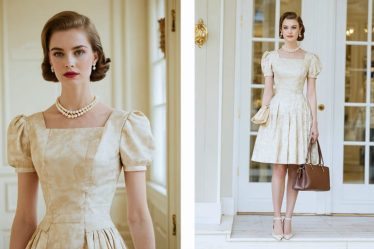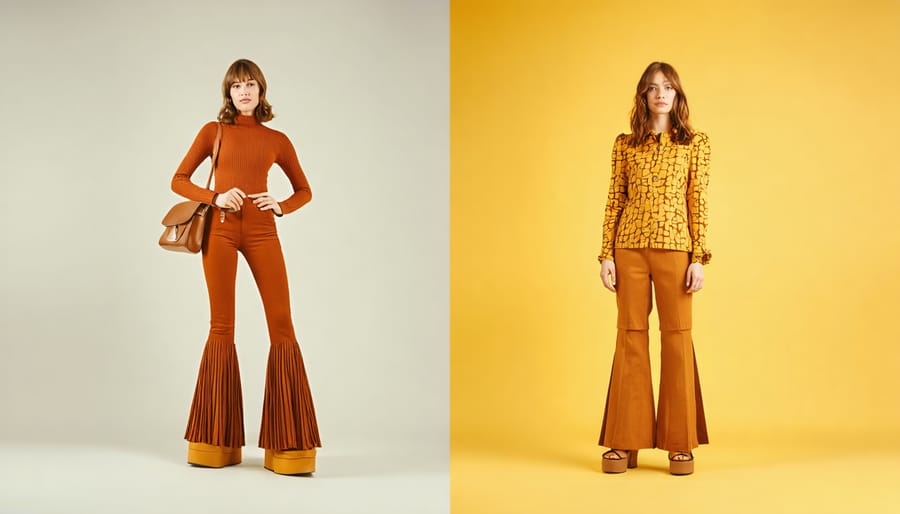
Bell bottoms, peasant blouses, and platform shoes are dancing their way back into our closets, but this time with a sustainable twist. The ’70s fashion revival isn’t just about recreating iconic looks – it’s about mindfully incorporating vintage elements into modern wardrobes while respecting our planet. From thrift store treasures to eco-friendly fabrics that channel that coveted bohemian vibe, today’s interpretation of ’70s style proves that what goes around comes around, only better.
This resurgence celebrates the era’s most beloved signatures: earthy color palettes, flowing silhouettes, and bold patterns, now reimagined through a contemporary lens. Whether you’re drawn to the free-spirited essence of festival fashion or the sophisticated swagger of disco-era suits, the modern ’70s revival offers something for every fashion enthusiast – without the polyester overload of the original decade.
As we embrace this nostalgic trend, we’re not just wearing fashion history; we’re rewriting it with sustainable practices and conscious choices. The result? A groovy blend of past and present that’s as kind to the Earth as it is stylish.
Why 70s Fashion is Perfect for Today’s Conscious Consumer
The Timeless Appeal of 70s Design
The allure of the 1970s continues to captivate fashion enthusiasts, and it’s no wonder why the 70s style revival feels so relevant today. There’s something magical about how the era’s signature elements – from earthy color palettes to flowing silhouettes – seamlessly blend with contemporary fashion. I remember discovering my mom’s vintage maxi dress and being amazed at how current it looked, even decades later.
What makes 70s design truly timeless is its celebration of individual expression and comfort. The decade’s hallmark features – high-waisted pants, platform shoes, and bold prints – speak to our modern desire for both style and self-expression. These elements work particularly well with today’s mix-and-match approach to fashion, allowing us to incorporate vintage-inspired pieces while maintaining a fresh, current look.
The era’s emphasis on natural materials and handcrafted details also resonates with our growing appreciation for sustainability and authenticity in fashion. Whether it’s a crochet vest or suede fringe bag, these pieces tell a story while adding character to our wardrobes.
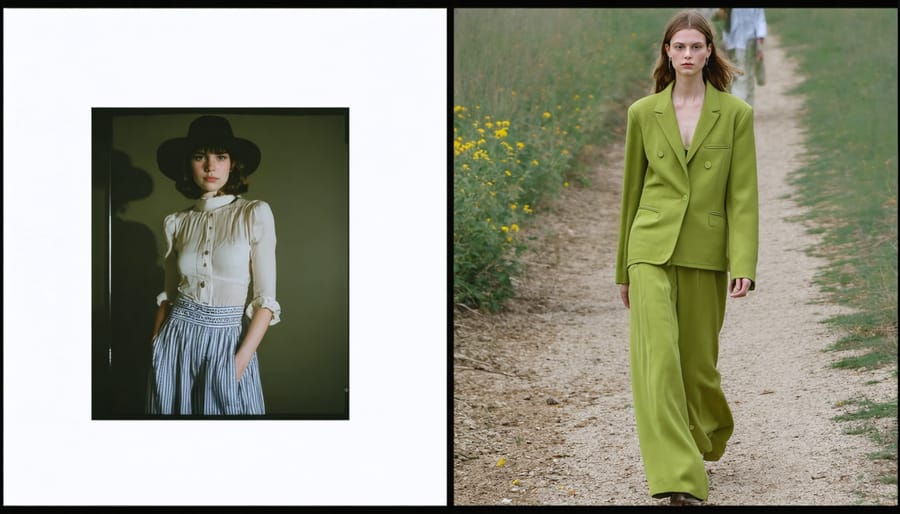
Sustainability Meets Style
The beauty of the ’70s fashion revival lies in how naturally it aligns with modern sustainable fashion practices. Just as our flower-power predecessors embraced natural fibers, handcrafted items, and long-lasting pieces, today’s conscious consumers are returning to these same principles. The decade’s love for cotton, wool, and other biodegradable materials mirrors our current push toward eco-friendly fashion choices.
Thrifting and upcycling, staples of ’70s counter-culture, are now mainstream practices that reduce fashion waste. The era’s signature pieces – from denim flares to crochet tops – are often found in vintage stores, giving these timeless items a second life. Even the decade’s DIY approach to fashion, like tie-dying and patch-working, encourages creative reuse and personalization of existing garments.
By embracing ’70s fashion, we’re not just adopting a style; we’re participating in a movement that values longevity, craftsmanship, and environmental consciousness.
Key 70s Pieces Making a Sustainable Comeback
Statement Denim
Denim is having a major comeback, and the 70s silhouettes are leading the charge. Wide-leg jeans, high-waisted cuts, and vintage-wash denim are everywhere, but this time with a sustainable twist. Look for brands that use recycled materials or eco-friendly production methods – many specialty vintage shops now curate pre-loved denim pieces that perfectly capture that coveted 70s vibe. When styling, pair your statement denim with a fitted turtleneck or a flowy blouse to balance the proportions. For an authentic touch, seek out details like contrast stitching, patch pockets, and slight distressing. Local thrift stores often hide gems like original 70s Levi’s or Wranglers, which not only look incredible but also support circular fashion. Remember, the key to nailing this trend is finding pieces that make you feel confident while treading lightly on the planet.
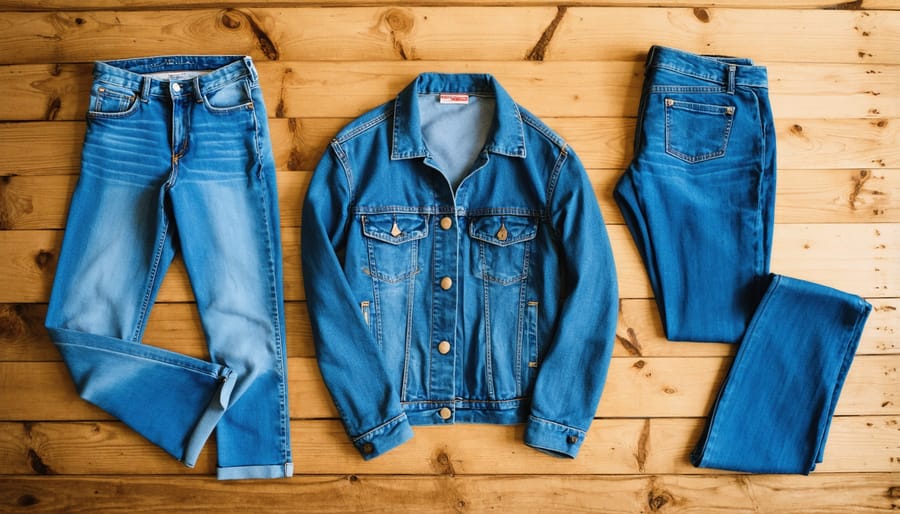
Natural Fabrics and Earth Tones
The revival of 70s fashion brings with it a renewed appreciation for natural fabrics and earth-toned color palettes, perfectly aligned with today’s sustainable fashion movement. I’ve noticed more and more fashion-forward women embracing materials like organic cotton, hemp, and raw silk – fabrics that were staples of the original hippie era but now come with modern eco-conscious certifications.
The warm, grounding colors of the 70s are making a major comeback. Think rich browns, warm terracotta, sage green, and golden yellows – hues that not only echo the decade’s signature palette but also create a versatile foundation for any wardrobe. I love how these earth tones work seamlessly with both vintage and contemporary pieces.
What makes this trend particularly special is how it combines style with sustainability. By choosing natural materials like linen and wool, you’re not just channeling that authentic 70s vibe – you’re also making environmentally conscious choices. These materials are biodegradable and often require less processing than synthetic alternatives. Plus, they tend to age beautifully, developing character over time just like those cherished vintage pieces we hunt for in thrift stores.
Vintage-Inspired Accessories
When it comes to channeling that authentic 70s vibe, accessories are your secret weapon – and the best part is, you can often find them sustainably! I recently scored the most amazing vintage leather crossbody bag at my local thrift store, and it’s become my absolute favorite conversation starter.
Look for signature pieces like oversized sunglasses with colored lenses, wide-brimmed felt hats, and structured handbags in rich earth tones. Platform sandals and chunky heels are making a major comeback, and you can often find pristine vintage pairs online or in secondhand shops.
Don’t forget about jewelry – layered necklaces, statement pendants, and wooden bangles are quintessentially 70s. I love mixing vintage pieces with modern minimalist jewelry for a fresh take on the retro look. Keep an eye out for natural materials like wood, cork, and bamboo in accessories – they’re not only sustainable but perfectly capture that laid-back 70s spirit.
Consider starting your vintage hunt at estate sales or local antique markets. These places often have incredible finds at reasonable prices, and there’s something special about giving these pieces a second life in your wardrobe.
How to Build a Sustainable 70s-Inspired Wardrobe
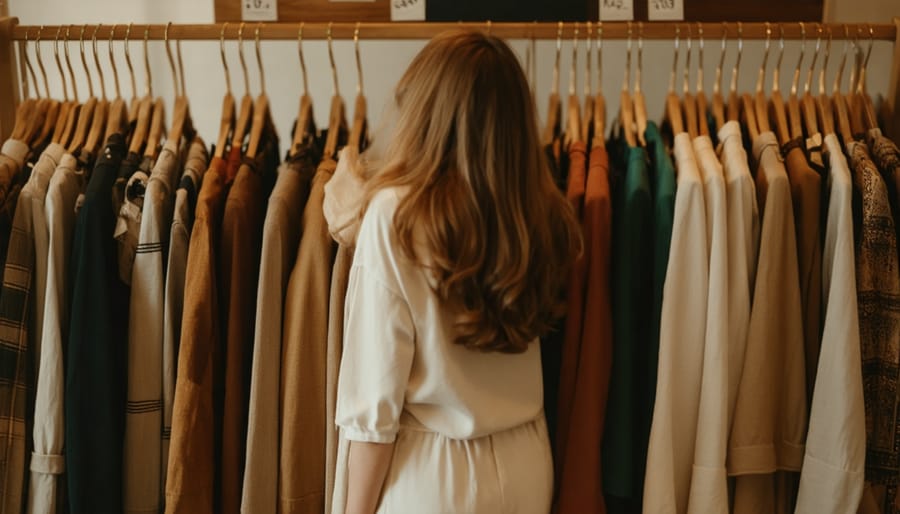
Thrifting Tips and Tricks
As someone who’s spent countless hours hunting for vintage treasures, I can tell you that finding authentic 70s pieces is like going on a thrilling treasure hunt. Start by researching local vintage shops and thrift stores in your area’s older neighborhoods – these often yield the best finds. When I’m thrifting, I always head straight to the natural fiber sections first, as polyester and other synthetics from the 70s tend to deteriorate over time.
Look for telltale signs of authentic vintage pieces: check the labels (they should look aged and may feature outdated brand logos), examine the stitching (70s garments often feature sturdier construction), and pay attention to zipper styles (metal zippers were common in that era). The best days to thrift are usually mid-week mornings when new items have just been put out and the crowds are thinner.
Don’t overlook estate sales and flea markets – I’ve found some of my favorite pieces at these venues. When shopping online, search for specific 70s terms like “disco era,” “bohemian,” or “bell-bottoms.” Remember to inspect items carefully for any damage, and always try pieces on when possible – sizing was different in the 70s.
Pro tip: Build a relationship with your local vintage shop owners. They often set aside pieces for regular customers and can alert you when something special comes in that matches your style preferences.
Modern Meets Vintage
The beauty of today’s ’70s revival lies in its versatility and eco-conscious approach. Building a sustainable wardrobe doesn’t mean choosing between modern and vintage – it’s about creating the perfect blend of both worlds.
I’ve found that pairing contemporary sustainable brands with authentic vintage pieces creates outfits that feel both fresh and nostalgic. For instance, try matching a newly purchased organic cotton bell-sleeve blouse with genuine ’70s high-waisted jeans. The combination celebrates the era’s spirit while supporting today’s ethical fashion movement.
Local vintage shops and sustainable fashion brands are becoming natural allies in this revival. Many eco-conscious designers now draw inspiration from ’70s silhouettes, creating pieces that complement original vintage finds perfectly. Think platform sandals from contemporary sustainable brands paired with authentic vintage maxi dresses, or modern recycled-material jumpsuits accessorized with original ’70s jewelry.
The key is to look for quality in both vintage and modern pieces. When shopping contemporary brands, focus on those using eco-friendly materials and ethical production methods. For vintage pieces, examine the construction and fabric quality – many ’70s garments were built to last, which is why they’re still wearable today.
Remember, mixing eras isn’t just stylish – it’s a sustainable approach to fashion that reduces our environmental impact while creating unique, personalized looks.
Care and Maintenance
Taking care of vintage pieces from the ’70s requires a gentle touch and some extra attention, but it’s absolutely worth the effort to keep these treasures looking their best. I’ve learned through experience that proper storage is crucial – always hang delicate items on padded hangers and store knits flat to maintain their shape. For those gorgeous polyester pieces that defined the era, hand washing in cool water with a mild detergent works wonders.
When it comes to those iconic platform shoes and boots, invest in good leather conditioner and store them with shoe trees to maintain their structure. For delicate materials like silk and chiffon, consider using a garment bag to protect them from dust and light exposure. One of my favorite tips is to air out vintage clothing regularly – it helps prevent musty odors that can develop over time.
Dealing with stains? Always test cleaning solutions on a hidden area first, and avoid harsh chemicals that could damage vintage fabrics. For basic maintenance, a gentle steam treatment can refresh most garments without risking damage. Remember to check and reinforce any loose seams or buttons promptly – small repairs can prevent bigger issues down the line.
Don’t forget about those statement accessories! Clean metal jewelry with a soft cloth and store in individual pouches to prevent tarnishing. For those amazing macramé bags, regular gentle brushing helps maintain their texture and appearance.
The resurgence of 70s fashion isn’t just about nostalgia – it’s a testament to the enduring appeal of an era that celebrated individuality and self-expression. By embracing these vintage styles today, we’re not only making a fashion statement but also contributing to a more sustainable future. Thrifting authentic 70s pieces or choosing modern interpretations made from eco-friendly materials helps reduce fashion waste while building a unique wardrobe that stands out from fast fashion trends. The beauty of 70s fashion lies in its versatility and timelessness – whether you’re rocking wide-leg pants for a business meeting or sporting a crochet top at a weekend brunch, these pieces seamlessly blend with contemporary styles. As we continue to prioritize both personal style and environmental consciousness, the 70s revival offers the perfect solution: fashion that’s as good for the planet as it is for our closets.



